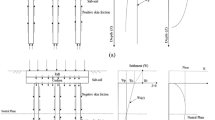Abstract
The protection of industrial facilities, classified as hazardous, against accidental or intentional explosions represents a major challenge for the prevention of personal injury and property damage, which also involves social and economic issues. We consider here the use of physical barriers against the effects of these explosions, which include the pressure wave, the projection of fragments and the thermal flash. This approach can be recommended for the control of major industrial risks, but no specific instructions are available for its implementation. The influence of a protective barrier against a detonation-type explosion is studied in small-scale experiments. The effects of overpressure are examined over the entire path of the shock wave across the barrier and in the downstream zone to be protected. Two series of barrier structures are studied. The first series (A) of experiments investigates two types of barrier geometry with dimensions based on NATO recommendations. These recommendations stipulate that the barrier should be 2 m higher than the charge height, the thickness at the crest should be more than 0.5 m, while its length should be equal to twice the protected structure length and the bank slope should be equivalent to the angle of repose of the soil. The second series (B) of experiments investigates the influence of geometrical parameters of the barrier (thickness at the crest and inclination angles of the front and rear faces) on its protective effects. This project leads to an advance in our understanding of the physical phenomena involved in the propagation of blast waves resulting from an external explosion, in the area around a protective physical barrier. The study focuses on the dimensioning of protective barriers against overpressure effects arising from detonation and shows the advantage of using a barrier with a vertical front or rear face.












Similar content being viewed by others
References
Zhou, Z.Q., Hao, H.: Prediction of airblast loads on structures behind a protective barrier. Int. J. Impact Eng. 35, 363–375 (2008)
Allain, L.: Barricade Influence on Blast Wave Propagation. Report, SNPE / Division Défense Espace, Vert-le-Petit, France (1994)
Borgers, J.: Blast walls reviewed. In: 21st International Symposium on Military Aspects of Blast and Shock, Jerusalem, Israel (2010)
Guide SFEPA \({\rm n}^{\circ }\)9. Guide des Bonnes Pratiques en Pyrotechnie—Edition Syndicat des Fabricants d’Explosifs, de Pyrotechnie et d’Artifices (2009)
Éveillard, S., Lardjane, N., Vinçont, J.Y., Sochet, I.: Towards a fast-running method for blast-wave mitigation by a prismatic blast wall. Compte Rendus Mecanique 341, 625–635 (2013)
Sochet, I., Sauvan, P.E., Boulanger, R., Nozeres, F.: Effect of a gas charge explosion at the closed end of a gas storage system. J. Loss Prev. Process Ind. 27, 42–48 (2014)
Trélat, S., Sochet, I., Autrusson, B., Cheval, K., Loiseau, O.: Strong explosion near a parallelepipedic structure. Shock Waves 16, 349–357 (2007)
Kinney, G.F., Graham, J.K.: Explosive Shocks in Air, 2nd edn. Springer-Verlag, Berlin (1985)
TM5-1300, U.S. Department of the Army.: Structures to Resist the Effects of Accidental Explosions. Army TM 5-1300, Navy NAVFAC P-397, AFR 88-22. Departments of the Army, Navy and Air Force, Washington, DC (2008)
Eveillard, S.: Propagation d’une onde de choc en présence d’une barrière de protection. PhD Thesis, Orleans University, France (2013)
Acknowledgments
This study is part of the BARPPRO ANR research programme (dimensioning physical protective barriers against propagation of pressure waves following an explosion). The work was carried out at the ANR and CEA, who provided financial support.
Author information
Authors and Affiliations
Corresponding author
Additional information
Communicated by C.-Y. Wen.
Rights and permissions
About this article
Cite this article
Sochet, I., Eveillard, S., Vinçont, J.Y. et al. Influence of the geometry of protective barriers on the propagation of shock waves. Shock Waves 27, 209–219 (2017). https://doi.org/10.1007/s00193-016-0625-4
Received:
Revised:
Accepted:
Published:
Issue Date:
DOI: https://doi.org/10.1007/s00193-016-0625-4




